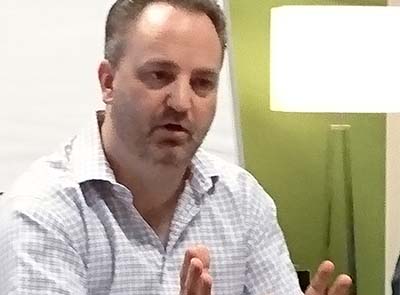Kathy Gibson reports from VMworld 2016 in Barcelona – IT needs to make a fundamental shift, to stop facing the data centre and rather face end users and customers.
“In the past, IT faced the data centre, so conversations tended to be about the data centre,” Joe Baguley, vice-president and chief technology officer: EMEA of VMware. “But transformed organisations have turned about-face and are now facing users and customers.”
In fact, IT is entering a new phase of its existence, he says. “Thanks to consumer companies, and consumer-facing organisations showing how to do things at speed and scale, businesses need to do thing the same way.”
A lot of traditional IT systems, however, don’t cater to this new realities, Baguley says. “For instance, the most expensive applications are not really designed to make users’ lives easier. Organisations that have been successful with digital transformation, however, are focusing on users and on customers.”
Digital transformation, Baguley believes, will really be about IT slowly turning itself around to face its customers.
“At VMware, we have been focusing on that, on catering to our customers’ customer. Traditionally our customer has been the IT department, but now they are having to sell services to their customers.”
VMware is helping IT to deliver on this new mandate by providing a managed and secure experience for end users, and providing an infrastructure that delivers applications securely on any device.
“We have to make the infrastructure automated, simple and with unprecedented choice,” Baguley says. “Our story is any cloud, any application, any device.”
Applications stand at the centre of this strategy, he adds. “We are building a platform for applications.”
Ray O’Farrell, executive vice-president and chief technology officer of VMware, points out that making the change to be customer- and user-facing is not easy for organisations.
“Different companies have different cultures and we should try to understand each company’s culture.”
For most organisations, however, the shifts in the marketplace and the move to digital transformation mean that CIOs need to start asking a different set of questions.
“The IT organisations we speak to used to complain about certain things: shadow IT; why developers don’t use the tools provided; why IT is expected to protect systems that it had no role in providing; and others.
“As organisations have pivoted into digital transformation, into a mode where they will succeed, they need to really understand what their customers want – to change; and to do it a highly digital fashion.”
What this does is move IT right into the heart of the success of the business itself, O’Farrell says. “They are in the front line of the business and expected to attract customers, get the right product into the market and enable the supply chain.
“So what they need to worry about changes as well – because if IT screws up, the whole company loses out.”
And, although IT organisations are changing what they worry about, this places new demands on the infrastructure.
“The focus now is on agility, customer centricity and understanding what customers want,” O’Farrell says. “So, although some of the things they used to worry about are no longer important, IT still needs to focus on what is the best way to run the application, what the new SLA needs to be, agility, and responsiveness to customer expectations.”
It might actually be a misnomer to call it IT any more, O’Farrell adds. “IT today is really the digital interface to the world.”
How Amadeus is changing
Amadeus is an example of a company that has had to change the way it delivers IT services to its customers.
Dr Wolfgang Krips, executive vice-president: global operations and GM of the Amadeus IT Group, explains that there has been a fundamental shift in power to the end user.
“In the world of online travel bookings, there is no customer loyalty – if a service is not available, there are 15 other sites. So the expectation is that a service will be 100% available.”
Not only do airlines need 100% availability, they also need a lot more flexibility as well.
“Airlines are in a business that is largely determined by fixed costs,” Dr Krips says. “So they need to add services to increase revenue.”
He points out that this has two implications: they need to understand the customer a lot better; and they need to have backend systems that allow them to offer extra features.
“This puts us in the uncomfortable position of having to increase both stability and agility,” he says. “In the past this would have been a trade-off. And the only way to deliver this is to automate, and to take humans out of the picture.
“The IT organisation has to rethink how it delivers services, and the applications need to adhere to these paradigms.”

